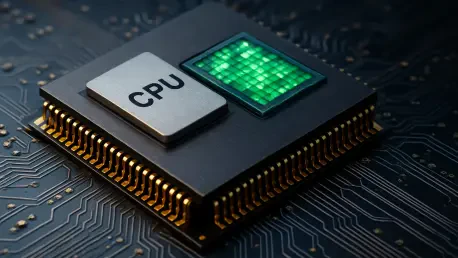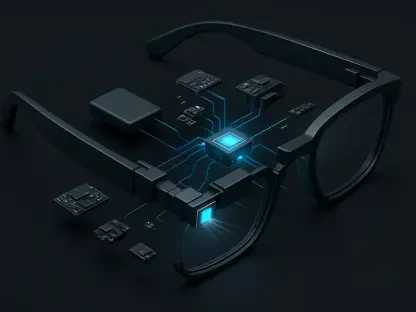In a seismic shift for the tech industry, Intel and Nvidia, two long-standing titans of the semiconductor realm, have joined forces in a partnership that could fundamentally alter the landscape of computing with a new breed of hybrid processors. With Nvidia’s substantial $5 billion investment in Intel, securing a 4-5% stake through common stock, this collaboration goes beyond mere financial backing to promise innovative technology. By melding Intel’s deep-rooted expertise in x86 CPU architecture with Nvidia’s unparalleled advancements in GPU and AI technologies, the alliance aims to create custom chips that could power everything from sprawling data centers to the sleek laptops on everyday desks. This move signals a departure from decades of rivalry, focusing instead on a shared vision to address the escalating demands of modern computing challenges like artificial intelligence, high-performance graphics, and energy efficiency. The potential to blur the traditional boundaries between CPU and GPU functionalities raises intriguing questions about the future. Could this partnership usher in a new era where hybrid chips become the standard, transforming the devices relied upon daily? As anticipation builds, the industry watches closely to see if this collaboration can deliver on its lofty promises and redefine personal and enterprise computing in ways previously unimaginable.
A Strategic Shift in the Semiconductor Landscape
The partnership between Intel and Nvidia represents a pivotal moment in the semiconductor industry, where competition is giving way to strategic cooperation to tackle complex technological demands. Nvidia’s significant investment in Intel isn’t just a monetary transaction but a symbol of mutual trust and aligned goals. This alliance leverages Intel’s manufacturing capabilities and long-standing dominance in CPU design alongside Nvidia’s innovative strides in graphics and AI acceleration. The result could position both companies as frontrunners in a market increasingly defined by integrated solutions, directly challenging competitors who have already made inroads with their own hybrid architectures. Beyond the financials, this collaboration hints at a broader industry trend where synergies are sought to meet the needs of data-intensive applications and power-efficient consumer devices. The focus on co-developing custom x86-based CPUs for enterprise environments and system-on-chip processors for personal computing suggests a comprehensive approach to innovation that could ripple across multiple sectors.
Equally compelling is the potential impact on market dynamics, as this partnership could reshape how technology leaders vie for dominance. By combining their strengths, Intel and Nvidia aim to create processors that don’t just compete but set new benchmarks for performance and efficiency. This strategic move aligns with the growing demand for versatile computing solutions capable of handling diverse workloads, from AI-driven analytics to immersive gaming experiences. The collaboration also serves as a response to the pressure from other industry players who have successfully integrated CPU and GPU functionalities into singular, powerful chips. As the semiconductor landscape evolves, this alliance may well redefine the competitive edge, pushing the boundaries of what integrated hardware can achieve. While the full scope of this impact remains to be seen, the groundwork laid by this partnership indicates a future where hybrid computing could become the norm rather than the exception.
Technological Synergies Fueling Innovation
At the core of this groundbreaking collaboration lie Nvidia’s cutting-edge technologies, poised to enhance Intel’s chip designs in transformative ways. One standout feature is NVLink, a high-bandwidth, low-latency interconnect that significantly outpaces conventional data transfer standards like PCI Express. By embedding NVLink into hybrid processors, the partnership aims to eliminate longstanding bottlenecks in data-heavy tasks, such as real-time graphics rendering and AI model training. This could mean smoother, faster performance in both consumer devices and enterprise systems, where rapid data exchange between CPU and GPU components is critical. The integration of such advanced interconnect technology points to a future where hybrid chips deliver unprecedented efficiency, potentially setting a new standard for how processing power is harnessed across a range of applications, from compact laptops to sprawling server farms.
Further amplifying the potential are Nvidia’s CUDA and Tensor cores, specialized units designed for parallel processing and AI-specific computations. When incorporated into Intel’s system-on-chip designs, these cores could dramatically boost the capabilities of consumer devices, enabling laptops to handle complex AI workloads or deliver workstation-grade graphics performance without the need for separate hardware. Additionally, Nvidia’s DLSS technology, which uses AI to upscale visual output, could revolutionize gaming and creative software on budget and midrange systems by enhancing resolution and frame rates. This synergy of technologies suggests a leap forward in making high-end features accessible to a wider audience. The prospect of such powerful integration raises expectations for devices that not only perform better but also redefine user experiences in professional and recreational computing tasks.
Transforming Consumer Computing Experiences
The implications of hybrid processors born from this alliance could be nothing short of revolutionary for consumer devices, particularly in the realm of AI-driven laptops and compact desktops. By embedding Nvidia’s GPU chiplets into Intel’s architectures, these systems might achieve computational power far surpassing current integrated solutions, enabling on-device processing for tasks like machine learning, data analysis, and natural language processing. This advancement could prove invaluable for students, researchers, and professionals who require robust tools without the burden of bulky or expensive hardware. The democratization of such capabilities means that high-performance computing could become a staple in everyday devices, breaking down barriers to advanced technology and fostering innovation across diverse fields. As AI continues to permeate various aspects of life, having laptops and desktops equipped to handle these workloads natively could redefine productivity and creativity.
Another exciting frontier lies in content creation and gaming applications, where hybrid chips could bridge significant gaps in performance and portability. For content creators, laptops with GPU-accelerated capabilities could transform video editing, graphic design, and 3D rendering into seamless experiences on slim, lightweight machines, rivaling the power of traditional workstations. Meanwhile, midrange gaming laptops might finally overcome the design compromises of balancing power with efficiency, offering impressive graphics in thinner profiles with better battery life. This could cater to a vast audience of casual and semi-serious gamers who prioritize convenience and cost over top-tier specs. The potential to integrate such robust graphical performance into mainstream devices hints at a shift in how technology serves varied user needs, making powerful tools more inclusive and reshaping expectations for what personal computing hardware can achieve.
Navigating Market Challenges and Future Uncertainties
Despite the palpable excitement surrounding this collaboration, significant hurdles remain in translating technological promise into market success. One pressing concern is pricing—will consumers embrace these hybrid processors if they come with a hefty cost, especially without concrete performance data to justify the investment? Comparisons to existing premium devices suggest that value will be a critical factor in adoption. Moreover, the absence of a definitive timeline for product launches introduces an element of uncertainty, even as indications from industry leaders point to ongoing progress behind the scenes. The challenge lies in balancing innovation with accessibility, ensuring that these advanced chips don’t remain out of reach for the average user. As anticipation builds, the industry awaits benchmarks and real-world applications to gauge whether the hype matches the eventual delivery.
Another layer of complexity emerges in defining and marketing this new category of processors, which sit between traditional integrated graphics and discrete GPUs. Crafting a clear identity—whether labeled as hybrid graphics or another term—will be essential to educate consumers and drive acceptance. This task is compounded by a competitive landscape where rival companies have already staked claims with their own integrated solutions, setting high expectations for performance and efficiency. Intel and Nvidia must not only innovate but also communicate the unique benefits of their hybrid chips to stand out. Overcoming these market challenges will require strategic positioning and perhaps a willingness to adapt based on early feedback. The road ahead is fraught with questions, but the potential to carve out a distinct niche in computing hardware keeps the stakes high for this ambitious partnership.
Envisioning the Next Steps for Hybrid Computing
Reflecting on the strides made through this alliance, it’s evident that Intel and Nvidia embarked on a journey that challenged conventional boundaries in semiconductor design. Their combined efforts to fuse CPU and GPU functionalities into hybrid processors sparked a wave of innovation, setting a precedent for what integrated hardware could accomplish. The focus on leveraging technologies like NVLink and Tensor cores demonstrated a commitment to addressing modern computing demands, from AI to immersive graphics, with solutions that prioritized both power and efficiency. Looking back, this collaboration stood as a testament to the power of strategic partnerships in overcoming historical rivalries for the greater good of technological advancement.
Moving forward, the path to redefining computing hinges on actionable steps that build on this foundation. Prioritizing transparent communication about product timelines and pricing strategies will be crucial to maintain consumer trust and enthusiasm. Equally important is the need to establish industry standards for hybrid processors, ensuring compatibility and fostering an ecosystem where software developers can optimize applications for these chips. Continued investment in research and development could further refine the balance between performance and affordability, making advanced computing accessible to broader markets. As the industry evolves, monitoring user feedback and competitive responses will provide invaluable insights, guiding Intel and Nvidia in shaping a future where hybrid computing not only meets but exceeds expectations.









